While 2023’s climate questions depended largely on governments and big bankers, 2024 is one of those years where the fate of the world rests in the hands of ordinary people.
But not all its people. Because of the USA’s huge emissions, financial power and electoral system, our hopes lie largely on those in a few swing states – like Pennsylvania, Wisconsin, Georgia and Arizona.
In 2020, we spoke to grassroots campaigners trying to boost climate voter turnout in Georgia. They were crucial in swinging the Senate then, which allowed a huge climate bill to be passed in 2022. The planet needs the likes of them again.
1.Who will win the US election?
Of all the world’s elections, the USA’s is the one that matters the most for the climate. The policies of the world’s second biggest polluter swing wildly depending on who is in the Oval Office.
The vote on November 5 is likely to pit Joe Biden against Donald Trump. Polls and bookmakers currently suggest Trump is more likely to win.
That would put a major dampener on climate hopes ahead of Cop29, on November 11.
We know where both men stand. As president, Trump withdrew the US from the Paris agreement. Biden re-joined it on his first day in office and pushed through $369bn of green spending.
On the same day as the Presidential election, Americans will also vote for all the seats in the House of Representatives and a third of those in the Senate.
Republican control of the House of Representatives is a big barrier to US climate finance. Given Democratic turnout is usually higher when there’s a Presidential election, there’s a chance Democrats could win control and at least deliver on their $3 billion promise to the Green Climate Fund.

Donald Trump being sworn in as US president in 2016 (Pic: White House photo)
2.What will the new global finance target be?
Compared to fossil fuels, finance was low profile in 2023 – to the anger of developing countries.
But 2024 should be its year, as countries have to negotiate a new finance goal for 2025 onwards by the time they leave Cop29 in Baku in November.
Expect debate over who should pay and who should receive, as well as how much should be given and to what.
Separately, France and Kenya have launched a taskforce on how to get money for climate which isn’t just from governments.
Options include taxes on international shipping, aviation, financial transactions and fossil fuels.
The US, Germany and others will continue their push to squeeze more money out of the World Bank and International Monetary Fund for climate.
3.Will emissions finally start going down?
Almost every year so far, the world’s humans have pumped out more greenhouse gas than any year before, sparking depressing headlines about “record emissions”.
But 2023 could well be the last year of this. A report by Climate Analytics finds a 70% chance that emissions will peak in 2023 and start falling in 2024.
The International Energy Agency thinks something similar – but the US government’s forecasters are more pessimistic.
Whether emissions peak or not, the amount of greenhouse gas in the atmosphere will keep going up. A bath tub doesn’t empty because you put less water in it each year – you have to pull the plug out.
Climate Analytics says emissions are likely to peak this year but how fast they decline depends on policies (Photos: Climate Analytics)
4.When will the loss and damage fund start spending?
Before rich nations agreed to a loss and damage fund at the end of 2022, they argued that it would take years and years to set up – too long to be useful.
After governments agreed on most of the details in 2023, 2024 may be the year they are proved wrong.
Regional groups are appointing their board members to the fund now.
Then the board needs to meet, agree policies, receive the money it’s been promised and start dishing it out.
What’s for sure is that there will be loss this year and there will be damage – droughts, heatwaves, storms and more. So the victims can’t wait.
5.Will countries firm up adaptation targets?
After two years of talks, at Cop28 this year governments agreed to draw up targets on adapting to climate change in areas like healthcare, food security and protecting nature.
They will now spend two years discussing whether there should be numbers attached to those targets and what those numbers should be.
Developing countries want the numbers – like a target to reduce adverse climate impacts on agricultural production by 50% by 2030.
But developed nations argue numbers can’t show how well you’ve adapted to climate change.
They will hash out this debate at Bonn in June and at Cop29 in Baku in November.

Seaweed farmers in Tanzania are having to move into deeper waters as seaweed-killing bacteria thrives in warming seas (Photo: Natalija Gormalova / Climate Visuals Countdown)
6.Will governments get rid of fossil fuel subsidies?
Since 2009, governments have kept promising to get rid of subsidies for fossil fuels – but not really doing so.
At Cop28, a dozen nations including France and Canada joined a coalition to try and finally turn this promise into action.
They committed to drawing up an inventory of their fossil fuel subsidies by Cop29 in November.
Inventories can lead to action. When a Dutch inventory revealed they were spending $40bn a year subsidising fossil fuels, protesters braved water cannons to block off the country’s parliament, rocketing the issue up the agenda. Will the same happen elsewhere?
7.Will coal-to-clean deals keep disappointing?
Just energy transition partnerships (Jetp) faced a brutal reality check in 2023, as investment blueprints were finally unveiled.
Rich countries are offering most of their money as loans not grants. Ambitious plans to switch off coal plants early in South Africa, Indonesia and Vietnam are now much more uncertain as a result.
As the money starts flowing in 2024, the implementation of the first few projects should give a flavour of how effective and just the transition will be.

The energy transition deal aims to wean Indonesia off coal, which now takes up nearly half of the country’s electricity mix. Photo: Kemal Jufri / Greenpeace
8.Will new treaty target plastic production?
Government negotiators are currently debating a draft of a new plastics treaty, which they hope to finalise by the end of 2024 – after meetings in Ottawa in April and Busan at the end of November.
One option being fiercely debated is whether to set limits on the amount of plastic each country can produce.
While the majority of European and African countries want limits, the US and Saudi Arabia are resistant.
Plastics are made from oil and gas. With electricity systems and vehicles transitioning to renewable electricity, oil and gas companies see plastics as a lifeline which this treaty could take away.
9.How will companies prepare for the EU’s carbon border tax?
Many developing countries have long seen the European Union’s carbon border tax and elements of the USA’s Inflation Reduction Act as unfair protectionist trade measures, dressed up in concern for the environment.
These complaints were high-profile at Cop28 – with China and others trying to get them put on the official agenda. The United Nation’s trade chief – Costa Rica’s Rebecca Grynspan – recently echoed these concerns and they’re likely to keep rising up the agenda in 2024.
The EU’s carbon border tax incentivises companies making certain polluting products outside of the EU to clean up their manufacturing – or at least to say they’re cleaning up. As the 2026 start date for the tax nears, we expect more stories about companies greenwashing to lessen their tax burden and about the impact of the tax on ordinary people in developing countries, aluminium workers in Mozambique for instance.

Bratsk aluminium smelting facility in Russia will be affected by the EU’s border tax (Photo credit: UC Rusal/WikiCommons)
10.Will carbon markets gain integrity?
Carbon markets – and the voluntary one, in particular – are facing a credibility crisis. Scandal after scandal has put the spotlight on the wildly exaggerated claims and environmental and social issues of many projects. Demand has slowed down as a result.
The Integrity Council for the Voluntary Carbon Market – a new regulator-like body – is trying to steer buyers away from dodgy offsets and onto quality ones. It is expected to apply its quality label on the first batch of credits at the start of the new year.
After talks collapsed at Cop28 earlier this month, Article 6 negotiations will resume in Bonn in June. The US and EU are at loggerheads. Another bitter battle seems likely.
The post Ten climate questions for 2024 appeared first on Climate Home News.
Climate Change
Guest post: Why China is still building new coal – and when it might stop
Last year, China started construction on an estimated 95 gigawatts (GW) of new coal power capacity, enough to power the entire UK twice over.
It accounted for 93% of new global coal-power construction in 2024.
The boom appears to contradict China’s climate commitments and its pledge to “strictly control” new coal power.
The fact that China already has significant underused coal power capacity and is adding enough clean energy to cover rising electricity demand also calls the necessity of the buildout into question.
Furthermore, so much new coal capacity provides an easy counterargument for claims that China is serious about the energy transition.
Did China really need more coal power?
And now that it is here, do all these brand-new power plants mean China’s greenhouse gas emissions will remain elevated for longer?
This article addresses four common talking points surrounding China’s ongoing coal-power expansion, explaining how and why the current wave of new projects might come to an end.
New coal is not needed for energy security
The explanation for China’s recent coal boom lies in a combination of policy priorities, institutional incentives and system-level mismatches, with origins in the widespread power shortages China experienced in the early 2020s.
In 2021, a “mismatch” between the price of coal and the government-set price of coal-fired power incentivised coal-fired power plants to cut generation. Furthermore, power shortages in 2020 and 2022 revealed issues of inflexible grid management and limited availability of power plants, when demand spiked due to extreme weather and elevated energy-intensive economic activity, compounded by coal shortages, reduced hydro output and insufficient imported electricity import.
Following this, energy security became a top priority for the central government. Local governments responded by approving new coal-power projects as a form of insurance against future outages.
Yet, on paper, China had – and still has – more than enough “dispatchable” resources to meet even the highest demand peaks. (Dispatchable sources include coal, gas, nuclear and hydropower.) It also has more than enough underutilised coal-power capacity to meet potential demand growth.
A bigger factor behind the shortages was grid inflexibility. During both the 2020 power crisis in north-east China and the 2022 shortage in Sichuan, affected provinces continued to export electricity while experiencing local shortages.
A lack of coordination between provinces and inflexible market mechanisms governing the “dispatch” of power plants – the instructions to adjust generation up or down – meant that existing resources could not be fully utilised.
Nevertheless, with coal power plants cheap to build and quick to gain approval, many provinces saw them as a reliable way to reassure policymakers, balance local grids and support industry interests, regardless of whether the plants would end up being economically viable or frequently used.
China’s average utilisation rate of coal power plants in 2024 was around 50%, meaning total coal-fired electricity generation could rise substantially without the need for any new capacity.
At the same time as adding new coal, the Chinese government also addressed energy security through improvements to grid operation and market reforms, as well as building more storage.
The country added dozens of gigawatts of battery storage, accelerated pumped hydro projects and improved trading linkages between electricity markets in different provinces.
Though these investments could have gone further, they have already helped avoid blackouts during recent summers – when few of the newly-permitted coal power plants had come online. As such, it is not clear that the new coal plants were needed to guarantee security of supply in the first place.
President Xi Jinping has stated that “energy security depends on developing new energy” – using the Chinese term for renewables excluding hydropower and sometimes including nuclear. According to the International Energy Agency, in the long run, resilience will come not from overbuilding coal, but from modernising China’s power system.
New coal power plants do not mean more coal use and higher emissions
It may seem intuitive to imagine that if a country is building new coal power plants, it will automatically burn more coal and increase its emissions.
But adding capacity does not necessarily translate into higher generation or emissions, particularly while the growth of clean energy is still accelerating.
Coal power generation plays a residual role in China’s power system, filling the gap between the power generated from clean energy sources – such as wind, solar, hydro and nuclear – and total electricity demand. As clean-energy generation is growing rapidly, the space left for coal to fill is shrinking.
From December 2024, coal power generation declined for five straight months before ticking up slightly in May and June, mainly to offset weaker hydropower generation due to drought. Coal power generation was flat overall in the second quarter of 2025.
The chart below shows growth in monthly power generation for coal and gas (grey), solar and wind (dark blue) and other low-carbon power sources (light blue).
This illustrates how the rise in wind and solar growth is squeezing the residual demand left for coal power, resulting in declining coal-power output during much of 2025 to date.
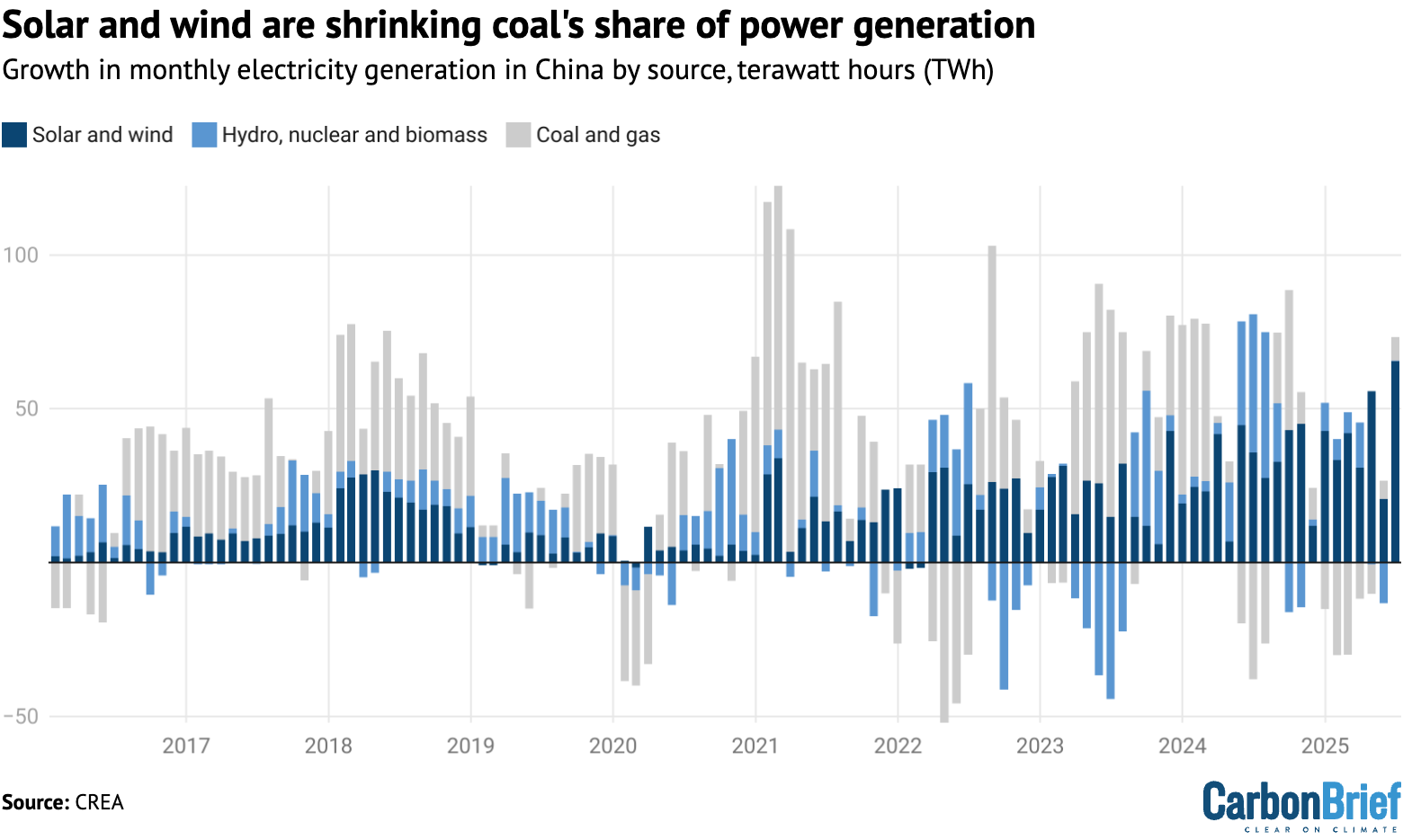
Another way to consider the impact of new coal-fired capacity is to test whether, in reality, it automatically leads to a rise in coal-fired electricity generation.
The top panel in the figure below shows the annual increase in coal power capacity on the horizontal axis, relative to the change in coal-power output on the vertical axis.
For example, in 2023, China added 47GW of new coal capacity and coal power output rose by 3.4TWh. In contrast, only 28GW was added in 2021, yet output still rose by 4.4TWh.
In other words, there is no correlation between the amount of new coal capacity and the change in electricity generation from coal, or the associated emissions, on an annual basis.
Indeed, the lower panel in the figure shows that larger additions of coal capacity are often followed by falling utilisation. This means that adding coal plants tends to mean that the coal fleet overall is simply used less often.
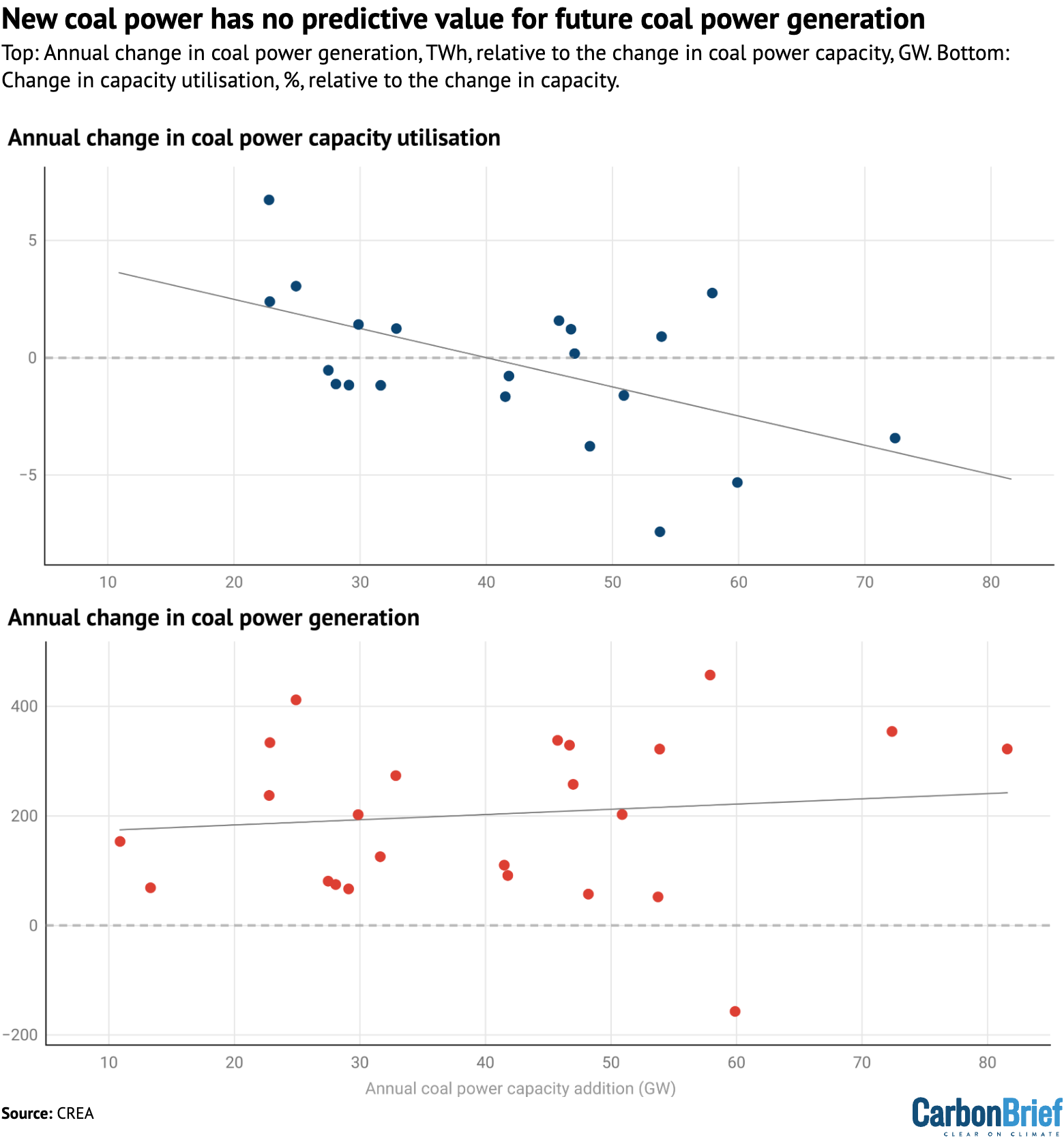
As such, while adding new coal plants might complicate the energy transition and may increase the risk of unnecessary greenhouse gas emissions, an increase in coal use is far from guaranteed.
If instead, clean energy is covering all new demand – as it has been recently – then building new coal plants simply means that the coal fleet will be increasingly underutilised, which poses a threat to plant profitability.
China is not unique in its approach to coal power
The dynamics behind last year’s surge in coal power project construction starts speak to the logic of China’s system, in which cost-efficiency is not always a central concern when ensuring that key problems are solved.
If a combination of three tools – coal power plants, storage and grid flexibility, in this case – can solve a problem more reliably than one alone, then China is likely to deploy all three, even at the risk of overcapacity.
This approach reflects not just a desire for reliability, but also deeper institutional dynamics that help to explain why coal power continues to be built.
But that does not mean that such a pattern is unique to China.
The figure below shows that, across 26 regions, a peak in coal-fired electricity generation (blue lines) almost always comes before coal power capacity (red) starts to decline.
Moreover, the data suggests that once there has been a peak, generation falls much more sharply than capacity, implying that remaining coal plants are kept on the system even as they are used increasingly infrequently.
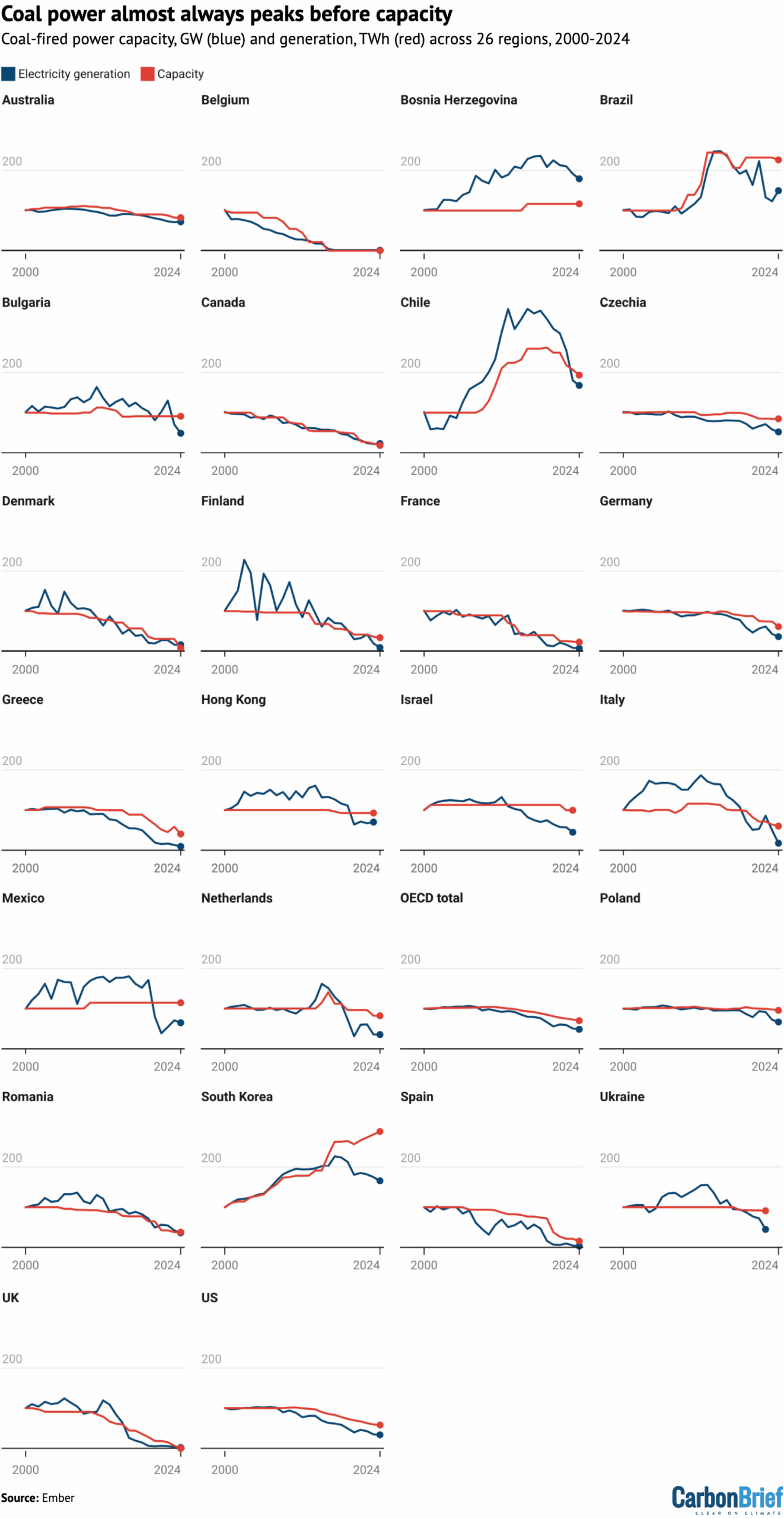
In most cases, what ultimately stopped new coal power projects in those countries was not a formal ban, but the market reality that they were no longer needed once lower-carbon technologies and efficiency gains began to cover demand growth.
Coal phase-out policies have tended to reinforce these shifts, rather than initiating them. In China, the same market signals are emerging: clean energy is now meeting all incremental demand and coal power generation has, as a result, started to decline.
Coal is not yet playing a flexible ‘supporting’ role
Since 2022, China’s energy policy has stated that new coal-power projects should serve a “supporting” or “regulating” role, helping integrate variable renewables and respond to demand fluctuations, rather than operating as always-on “baseload” generators.
More broadly, China’s energy strategy also calls for coal power to gradually shift away from a dominant baseload role toward a more flexible, supporting function.
These shifts have, however, mostly happened on paper. Coal power overall remains dominant in China’s power mix and largely inflexible in how it is dispatched.
The 2022 policy provided local governments with a new rationale for building coal power, but many of the new plants are still designed and operated as inflexible baseload units. Long-term contracts and guaranteed operating hours often support these plants to run frequently, undermining the idea that they are just backups.
Old coal plants also continue to operate under traditional baseload assumptions. Despite policies promoting retrofits to improve flexibility, coal power remains structurally rigid.
Technical limitations, long-term contracts and economic incentives continue to prevent meaningful change. Coal is unlikely to shift into the flexible supporting role that China says it wants without deeper reform to dispatch rules, pricing mechanisms and contract structures.
Despite all this, China is seeing a clear shift away from coal. Clean-energy installations have surged, while power demand growth has moderated.
As a result, coal power’s share in the electricity mix has steadily declined, dropping from around 73% in 2016 to 51% in June 2025. The chart below shows the monthly power generation share of coal (dark grey), gas (light grey), solar and wind (dark blue), and other low-carbon sources (light blue) from 2016 to the present.

When will the coal boom end?
About a decade ago, the end of China’s coal power expansion also looked near. Coal power plant utilisation declined sharply in the mid-2010s as overcapacity worsened. In response, the government began restricting new project approvals in 2016.
With new construction slowing and power demand rebounding, especially during and after the height of the Covid-19 pandemic, utilisation rates recovered. Not long after, power shortages kicked off the recent coal building spree.
Now, there are new signs that the coal power boom is approaching its end. Permitting is becoming more selective again in some regions, especially in eastern provinces where demand growth is slowing and clean energy is surging. Meanwhile, system flexibility is advancing.
Compared to the late 2010s, the current shift appears more structural. It is driven by the rapid expansion of clean energy, which increasingly eliminates the need for large-scale new coal power projects.
Still, the pace of change will depend on how quickly institutions adapt. If grid operators become confident that peak loads can reliably be met with renewables and flexible backup, the rationale for new coal power plants will weaken.
Equally important, entrenched interests at the provincial and corporate levels continue to push for new plants, not just as insurance, but as sources of investment, employment and revenue. Through long-term contracts and utilisation guarantees, this represents institutional lock-in that may delay the shift away from coal.
The next major turning point will come when coal power utilisation rates begin to fall more sharply and persistently. With large amounts of capacity set to come online in the next two years and clean energy steadily displacing coal in the power mix, a sharp drop in coal power plant utilisation appears likely.
Once this happens, the central government might be expected to step in through administrative capacity cuts – forcing the oldest plants to retire – just as it did during overcapacity campaigns in the steel, cement and coal sectors around 2016 and 2017.
In that sense, China’s coal power phase-out may not begin with a single grand policy declaration, but with a familiar pattern of centralised control and managed retrenchment.
A key question is how quickly institutional incentives and grid operation will catch up with the dawning reality of coal being squeezed by renewable growth, as well as whether they will allow clean energy to lead, or continue to be held back by the legacy of coal.
The upcoming 15th five-year plan presents a crucial test of government priorities in this area. If it wants to bring policy back in line with its long-term climate and energy goals, then it could consider including clear, measurable targets for phasing down coal consumption and limiting new capacity, for example.
While China’s coal power construction boom looks, at first glance, like a resurgence,it currently appears more likely to be the final surge before a long downturn. The expansion has added friction and complexity to China’s energy transition, but it has not reversed it.
The post Guest post: Why China is still building new coal – and when it might stop appeared first on Carbon Brief.
Guest post: Why China is still building new coal – and when it might stop
Climate Change
Analysis: England’s most ethnically diverse areas are 15 times more likely to face extreme heat
Neighbourhoods in England that are home to the most minority-ethnic people are 15 times more likely to face extreme heat than the least diverse areas, according to Carbon Brief analysis.
People with the lowest carbon footprints – who therefore contribute less to climate change – are also more likely to live in areas that experience high temperatures.
This is based on Carbon Brief analysis that combines satellite data on heat exposure with data on per-capita emissions, ethnicity and levels of deprivation across England.
Thousands of deaths in the UK have been attributed to heat in recent years and the threat is expected to grow as climate change worsens.
But heat is also felt differently across the country, with certain groups both more exposed and more vulnerable to dangerous temperatures.
Broadly, the analysis shows how those subject to the “urban heat island” effect in English cities, often in low-quality housing and with little access to green space, are more likely to experience extreme heat.
Experts tell Carbon Brief that policymaking should reflect the reality of climate change “amplifying” inequalities across society and provide help to those most in need, such as more heat-resilient social housing.
Heat threat
As greenhouse gas emissions and global temperatures rise, more people in the UK are likely to become ill or even die due to extreme heat.
Heat has killed around 6,000 people in England over the past three years, according to government figures. This is roughly double the number killed over the same period between 2016 and 2018.
Scientists have repeatedly linked extreme heat – and the resulting deaths – to climate change.
In June 2025 alone, more than 260 people died in London due to a heatwave, according to a recent attribution study that linked the event to climate change.
Government advisor the Climate Change Committee (CCC) estimates that the number of heat-related fatalities in the UK each year is set to triple by 2050, without adaptation measures.
Around half of homes in the country are already at risk of overheating and the CCC expects this to reach 90%, if global temperatures rise by 2C above pre-industrial levels.
However, these risks will not fall equally across society, with children, the elderly and disabled people more vulnerable to heat-related illness. There is also evidence that poorer communities and people of colour are more vulnerable to extreme heat.
Such communities also tend to have lower carbon footprints than those that are whiter and wealthier.
This fits with the broader concept of climate justice, which describes how people who are least responsible for climate change often end up bearing the brunt of its effects.
Carbon footprints
To investigate these issues, Carbon Brief combined detailed satellite data on heat exposure across England, provided by 4 Earth Intelligence, with neighbourhood-level carbon footprints compiled by the Centre for Research in Energy Demand Solutions (CREDS).
The CREDS dataset provides estimates of per-person carbon footprints, indicating how much the average person in each neighbourhood is contributing to climate change.
Due to data availability, this analysis focuses exclusively on England, the nation that experiences the most extreme heat in the UK.
Every neighbourhood is scored based on its “heat hazard”, meaning the likelihood that it will experience higher relative temperatures during hot weather, compared to surrounding areas.
The analysis then zooms in on the 10% worst-affected neighbourhoods in England. These neighbourhoods have a heat hazard score of 4 or 5, meaning that they face higher exposure to heat than 90% of areas around the country. (For a full explanation, see Methodology.)
The figure below shows that neighbourhoods with lower carbon footprints are twice as likely to face high heat hazard scores than areas with higher carbon footprints.
Specifically, it shows that 13.4% of neighbourhoods with the lowest carbon footprints are among the English areas most exposed to heat hazards. In contrast, only 7.0% of neighbourhoods with the highest carbon footprint are among the most heat-exposed areas.
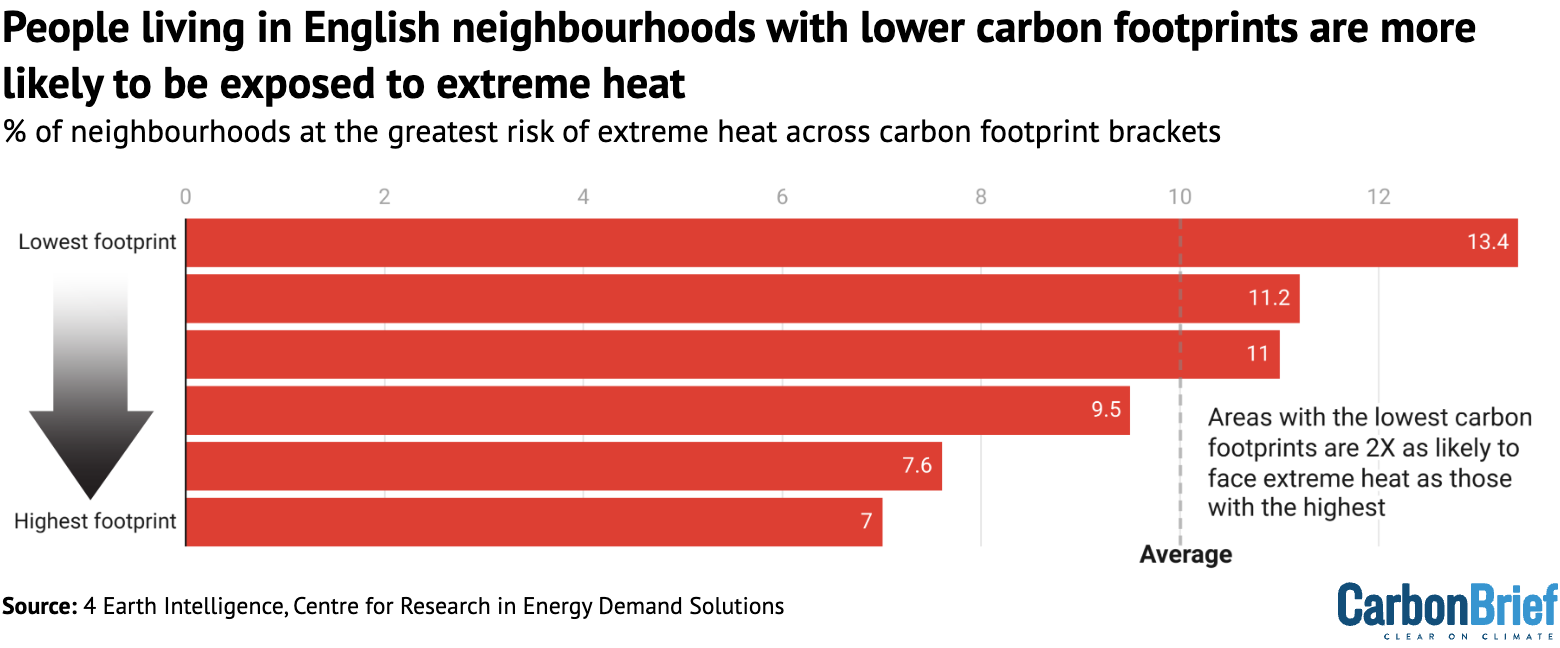
Neighbourhoods in England with lower carbon footprints are often in dense, urban areas, where people tend to be less reliant on cars and more likely to live in energy-efficient flats.
Areas with higher carbon footprints are commonly found in rural areas, where travelling by car can be a necessity due to limited public transport.
Also, particularly in south-east England, people in these rural neighbourhoods are often wealthier, meaning they spend more money on flights and other high-emitting luxuries.
Ethnicity and deprivation
Carbon Brief also analysed the heat threat facing deprived neighbourhoods in England and those that are home to more people of colour.
Information about how many people identify as black, Asian and other minority ethnicities in each neighbourhood is based on 2021 census data, via the Office for National Statistics.
As the chart below shows, there is a clear correlation between the number of people of colour living in a neighbourhood and the likelihood of it facing extreme heat during periods of hot weather.
The most ethnically diverse neighbourhoods – where roughly half or more of the population are people of colour – are 15 times more likely to have high heat hazard scores than the least ethnically diverse neighbourhoods, where almost everyone is white.
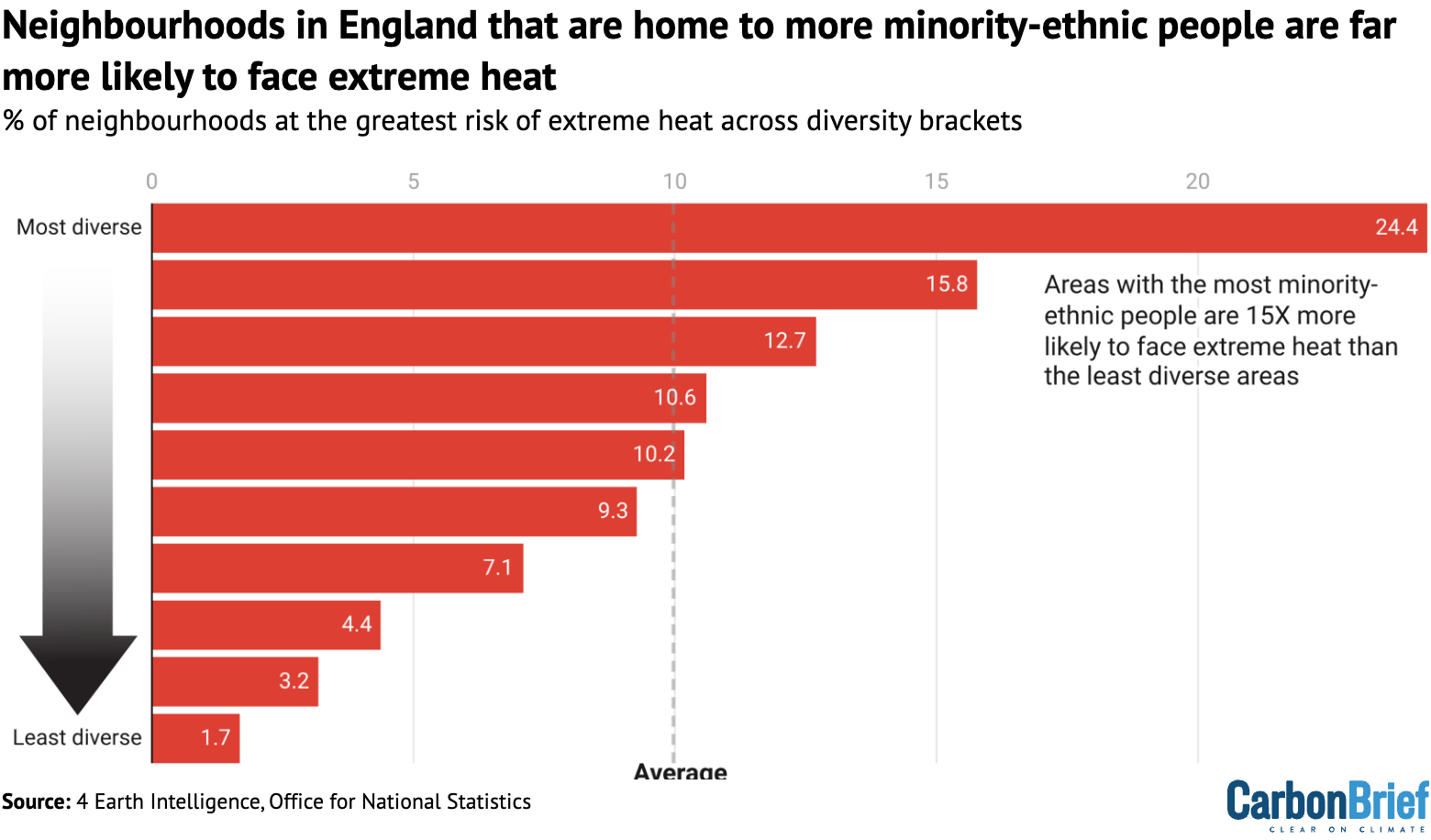
Among the most diverse areas are parts of Newham in east London, Saltley in Birmingham and Spinney Hills in Leicester, all of which are inner-city areas.
The least diverse neighbourhoods range from coastal parts of Redcar and Cleveland in North Yorkshire to the rural villages of south Somerset. None of England’s hottest 1% of neighbourhoods are in this bracket.
Additionally, Carbon Brief assessed the relationship between levels of poverty and heat risk, based on England’s indices of deprivation dataset. This covers several measures of deprivation, including income, employment and health.
People living in the most deprived English neighbourhoods are more than three times as likely to face high levels of heat hazard as those in the least deprived neighbourhoods, as shown in the figure below.
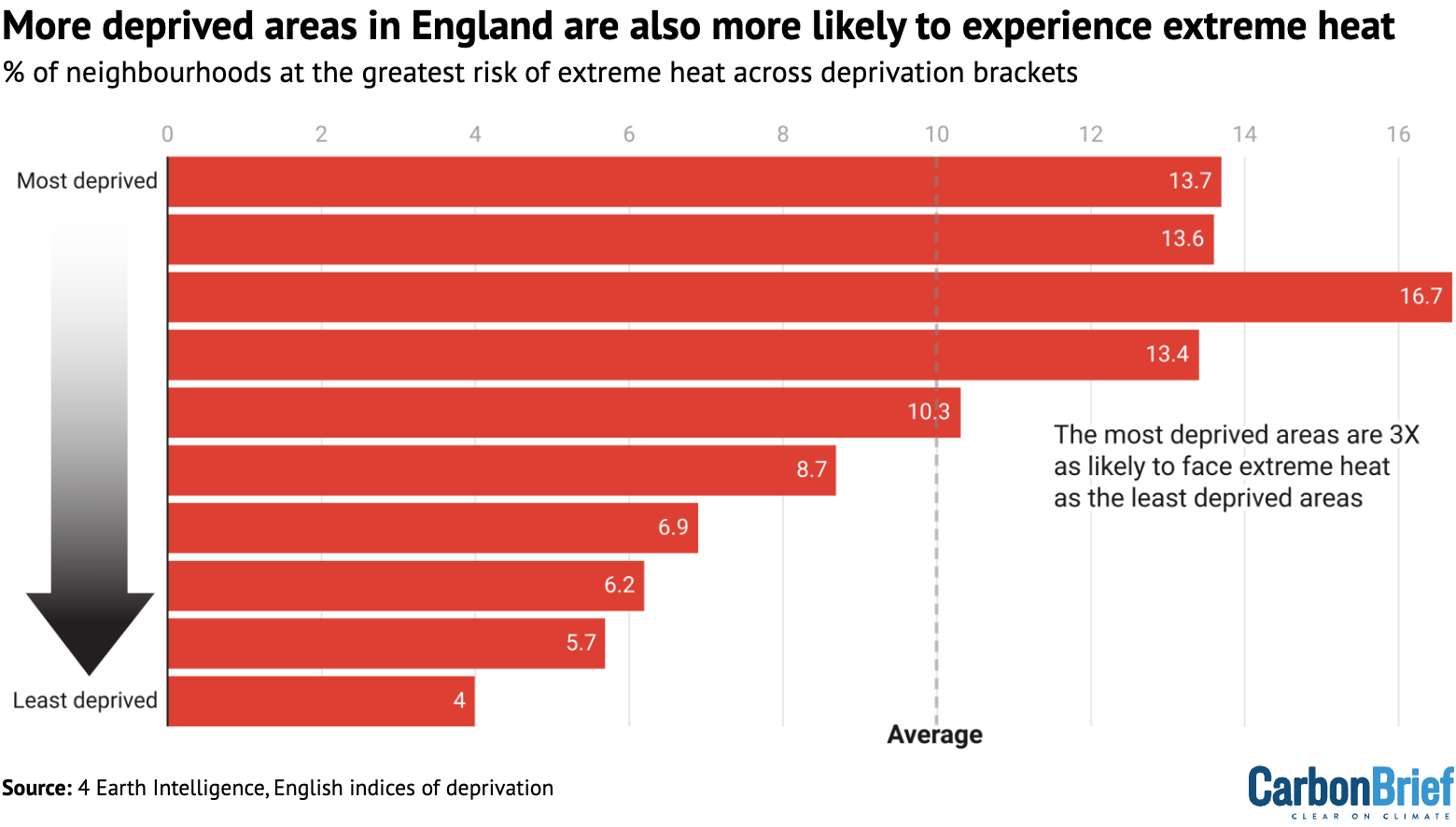
The correlation between poverty and extreme heat is less extreme than the one between heat exposure and ethnicity.
While many of England’s most deprived areas are in cities, they are also clustered in some rural and coastal areas – such as parts of Cornwall and Lincolnshire – which tend to be cooler.
Urban heat island
The key phenomenon captured by this analysis is the urban heat island effect. This describes how cities – and particularly areas with dense buildings, roads and stretches of concrete that absorb heat – tend to be hotter than the surrounding countryside.
Cities such as London, Manchester and Birmingham have reached temperatures up to 5C hotter than the surrounding areas in recent decades, due to this effect.
The diagram below shows how air flows circulate between rural and urban areas, forming “heat domes” over cities.
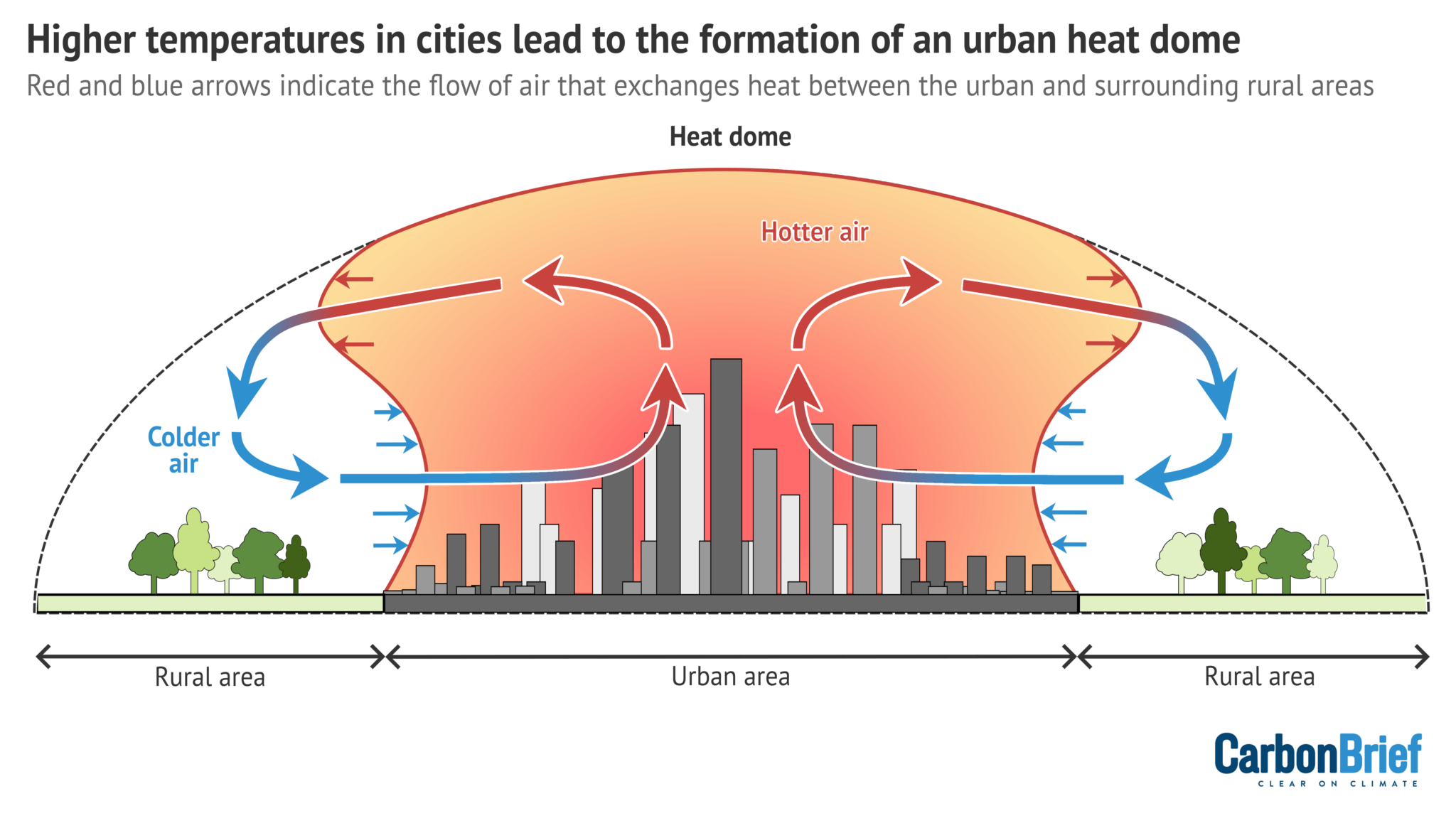
Inner-city areas in England are also home to many people facing high levels of deprivation, as well as large black and Asian communities. Many of these communities are therefore exposed to more dangerous temperatures due to the urban heat island effect.
Access to green spaces, even within cities, also influences exposure to the urban heat island effect. Research has shown how people in deprived areas and people of colour – particularly black people – are more likely to live in areas with less access to green spaces.
There is already extensive scientific literature that uses satellite data to demonstrate the urban heat island effect in cities and other locations.
A number of studies have also used this data to show how people of colour and those living in poverty are more exposed to extreme heat. Much of this research has come from the US, where historic housing inequalities have created stark patterns of segregation in many cities.
A project led by environmental policy researcher Dr Angel Hsu of the University of North Carolina-Chapel Hill shows how, globally, “cities are burdening lower-income populations with higher heat exposure”, as she tells Carbon Brief.
Given this, Hsu adds that “it’s not surprising to us to see similar disproportionate exposure patterns among UK neighbourhoods”.
Other researchers tell Carbon Brief that it is important to be wary of satellite data, as it does not precisely capture the air temperatures experienced in these neighbourhoods.
Dr Charles Simpson, who researches the health and economic impacts of climate change at University College London (UCL), notes:
“Satellite-measured surface temperature does not always correlate with the air temperature – what you are measuring includes a lot of road surfaces and rooftops. The air temperature is thought to be more directly relevant to people’s health and their cooling needs.”
Previous research has found that satellite data can therefore overestimate the urban heat island effect compared to data from weather stations.
These stations, however, are not widespread enough to allow comparisons with detailed neighbourhood data. They are particularly lacking in more deprived areas in England, potentially making measurements there less reliable.
Other scientists tell Carbon Brief that, in the absence of a comprehensive ground monitoring network, satellite measurements can serve as a stand-in to estimate heat exposure. Dr Chloe Brimicombe, an extreme-heat researcher based at the University of Graz, explains:
“Although it’s not a good indicator of perceived [temperature], it is a good indicator of what regions are most built up and have the environments that are most vulnerable to heat.”
‘Amplifying’ inequalities
There is a growing body of evidence gathered by activists, scientists and local governments around the UK revealing the unequal burden of climate change.
Dr Charles Ogunbode, an assistant professor of applied psychology at the University of Nottingham who specialises in how people experience climate change, tells Carbon Brief that this kind of data helps to clarify the links between climate change and inequalities:
“We can’t avoid dealing with the issue of social inequalities and climate change is just basically amplifying those things. It’s highlighting them, it’s revealing them. So whatever policies we put in place – be it in the health sector, be it in the climate sector – addressing those inequalities has to be an essential part of whatever those responses are.”
There are many factors influencing how people experience heat that are not captured in Carbon Brief’s analysis.
Previous work by researchers at the University of Manchester and Friends of the Earth has explored this issue, including an analysis of more than 40 indicators that could make neighbourhoods more “socially vulnerable” to heat.
This reveals similar outcomes, with people of colour and those contributing the least to climate change generally more vulnerable to its impacts.
One of the biggest factors that contributes to people’s exposure to heat extremes in the UK is the country’s housing stock, which is “not fit for the future”, according to the CCC.
UK homes have generally not been built for hotter conditions and poorer people are more likely to live in badly adapted housing. Those living in small homes, flats and social housing in England all “suffer significantly more overheating” during heatwaves, according to one study.
Dr Giorgos Petrou, a researcher in building physics modelling at UCL, tells Carbon Brief that it is also vital to consider whether households have the ability to adapt to climate change. “Amongst other factors, their capability will depend on their financial means and whether they own or rent their home,” he says.
Experts tell Carbon Brief that the government should act across its policy agenda to not only address extreme heat, but also support those who are most affected by it. This could involve expanding tree cover and renovating old social housing stock in at-risk communities.
Emma Howard Boyd, a former chair of the Environment Agency who also chaired the London Climate Resilience Review, tells Carbon Brief:
“I do think that with [the Labour] government focusing on house building and retrofit, this is a fantastic opportunity to get this right…For those communities that have had the least impact on the environment and climate change themselves.”
Methodology
This analysis collates several datasets that cover England at a neighbourhood level, with “neighbourhoods” defined as lower-layer super output areas (LSOAs). These are small statistical areas used by the UK government, covering populations of about 1,500-3,000 people. There are 33,755 LSOAs in England.
Data on vulnerability to heat comes from 4 Earth Intelligence (4EI), which analyses land surface temperature to generate “heat hazard” information at a 30m resolution. This detailed information has been converted into LSOAs by 4EI.
Heat hazard scores are calculated by 4EI, based on the likelihood that a given neighbourhood will experience high temperatures during hot weather, relative to the surrounding area.
Each score corresponds to a different percentile of English neighbourhoods. The bar below shows the percentage breakdown across all LSOAs in England.
The two hottest scores – those coloured in red – correspond to the 10% of English neighbourhoods that have higher heat hazard scores than the remaining 90%.

For simplicity, Carbon Brief’s analysis focuses on the red bars above, meaning neighbourhoods in either the top 90th-99th percentile or 99th percentile of heat hazard. (Neighbourhoods in the 90th-99th percentile have higher heat hazard scores than 90% of areas in England. Neighbourhoods in the 99th percentile have higher heat hazard scores than 99% of areas.)
It shows how these two scores are overrepresented in LSOAs that have lower carbon footprints, more diverse communities and higher levels of deprivation.
Carbon-footprint data is from the CREDS “place-based carbon calculator”, which estimates the average per-person carbon footprint for every LSOA in England. It accounts for emissions-producing activities ranging from electricity use to “consumption of goods and services”.
CREDS assigns the grades “A” to “F” (low carbon footprint to high carbon footprint) to neighbourhoods. Carbon Brief has based its carbon-footprint analysis on these grades.
LSOA-level data on black, Asian and other minority-ethnic populations comes from 2021 census data. English LSOAs were broken down into deciles, based on the percentage of the population that identified as non-white ethnicities.
The lowest decile covered the tenth of LSOAs with between 0 and 2% non-white minority-ethnic populations and the highest covered the tenth with more than 51%.
England’s indices of multiple deprivation dataset also includes LSOA-level information. It provides relative measures of deprivation for LSOAs in England, based on income, employment, education, health, crime, living environment and barriers to housing and services. Carbon Brief broke the LSOAs down into deciles based on the total deprivation scores, from the most deprived to the least deprived.
The post Analysis: England’s most ethnically diverse areas are 15 times more likely to face extreme heat appeared first on Carbon Brief.
Analysis: England’s most ethnically diverse areas are 15 times more likely to face extreme heat
Climate Change
Fossil-fuelled heat has caused tropical birds to decline by ‘up to 38%’ since 1950s
An uptick in heat extremes, driven by human-caused climate change, has caused tropical bird populations to decline by up to 38% since the 1950s, according to a first-of-its-kind analysis.
The study combines ecological and climate attribution techniques to trace the fingerprint of fossil-fuelled climate change on declining wildlife populations.
It shows that an increase in heat extremes driven by climate change has caused tropical bird populations to decline by 25-38% in the period 1950-2020, when compared to a world without warming.
The findings could help to explain why tropical bird numbers have declined even in pristine rainforests, a phenomenon that previously mystified biologists, the scientists say.
‘Chance encounter’
Over the past few decades, an emerging field of science known as “climate attribution” has used a standardised set of techniques to trace the fingerprint of human-caused warming on different elements of the climate system, ranging from worsening extreme weather events to episodes of glacier melt.
The new research, published in Nature Ecology and Evolution, is the first to use climate attribution techniques to detect the fingerprint of climate change on declining wildlife populations.
The study came about following a “chance encounter” between lead author Dr Maximilian Kotz, a climate scientist at the Barcelona Supercomputing Center in Spain, and his co-authors, who are biodiversity experts at the University of Queensland in Australia, while Kotz was completing a research stay in Australia.
Kotz says to Carbon Brief:
“As far as we are aware, this is the first animal climate attribution study.”
The researchers decided to focus on birds, rather than other animal species, as they have the “best available data, covering a good range of different species and geographies”, he adds.
Heat extremes
The authors examine how an intensification of heat extremes could have impacted bird populations, while controlling for other factors known to affect wildlife, including average temperature increase and human pressures, such as land-use change.
Episodes of extreme heat are known to have an immediate and long-lasting impact on birds, Kotz says:
“High temperature extremes can induce direct mortality in bird populations due to hyperthermia and dehydration. Even when they don’t [kill birds immediately], there’s evidence that this can then affect body condition which, in turn, affects breeding behaviour and success.”
Using statistical techniques, the scientists first analyse historical records to identify how bird populations have responded to fluctuations in climate, including heat extremes, over 1950-2020.
The team sourced global data on bird populations from the database that underlies the Living Planet Index, put together by the environmental charity WWF. They note it is the most comprehensive database available, but still has “clear geographic biases”, with global north regions better represented than those in the global south.
They use an attribution framework to estimate the extent to which human-caused warming influenced the changes in heat extremes observed in that time period, then calculate the impact of these climate-change-driven heat extremes on bird population changes from 1950-2020.
(The authors defined “heat extremes” as temperatures within the top 1% of daily temperatures over 1940-70, with data taken from ERA5, a global reanalysis dataset, which combines data from weather stations, satellites and model output.)
To understand how this would compare to a world without climate change, the researchers subtract this impact from the historical records.
Comparing their results to the counterfactual world without climate change allowed them to quantify how bird populations have changed as a result of human-driven increases in heat extremes.
Mapped
The research finds that human-driven heat extremes have had “strong negative impacts” on bird population numbers, with those residing at lower latitudes being the most affected.
The map below shows the percentage change in bird population abundance attributed to heat extremes over 1950-2018, when compared to a world without climate change.
On the map, dark red shows large decreases in population abundance, while light blue indicates small increases. (Abundance refers to the number of individual animals in a given population.)
The research finds that birds in the tropics have experienced the largest declines attributable to heat extremes.
It concludes that an uptick in heat extremes has caused tropical bird abundance levels to decline by 25-38% in the period 1950-2020, when compared to a world without warming.
The range in the size of that impact reflects the results of different models, which each use slightly different techniques to simulate changes to bird populations, Kotz says.
Tropical turmoil
In their paper, the authors note that their finding that tropical birds have experienced the most substantial declines are “consistent” with other studies indicating that “birds in these regions may be closer to the thermal limits at which impacts start to occur”.
They add that the findings are “particularly pertinent, given recent documentation of declining tropical bird populations, even in undisturbed habitats”.
One previous study found that in a “relatively undisturbed” part of the Amazon rainforest, bird abundance declined by more than 50% from 2003 to 2022. Similar results were found in a forest in Panama.
The authors of the new study say:
“The source of such declines have been noted as unknown, yet they are of a similar order of magnitude to our estimates of the impacts of intensified heat extremes.”
Their results suggest that “in tropical realms, climate change impacts on bird populations may already be comparable to land pressures that lead to habitat destruction and degradation”, the authors say.
This has “potential ramifications” for commonly proposed conservation strategies, such as increasing the amount of land in the the tropics that is protected for nature, they continue:
“While we do not disagree that these strategies are necessary for abating tropical habitat loss…our research shows there is now an additional urgent need to investigate strategies that can allow for the persistence of tropical species that are vulnerable to heat extremes.”
In some parts of the world, scientists and conservationists are looking into how to protect wildlife from more intense and frequent climate extremes, Kotz tells Carbon Brief.
He references one project in Australia which is working to protect threatened wildlife following periods of extreme heat, drought and bushfires.
Informing forecasts
As well as shedding light on what could be behind the rapid decline of birds in the tropics, the findings also underscore the importance of examining changes in climate extremes, rather than just annual global temperature rise, says Prof Alex Pigot, a biodiversity scientist at University College London (UCL), who was not involved in the research. He tells Carbon Brief:
“Most of the models that have been used to make projections of risk to biodiversity under future climate change use long-term climate averages and so the results of this study suggest that our existing risk assessments could be missing these critical impacts of climate change.
“We urgently need to address this and develop early warning systems to be able to anticipate in advance where and when extreme heatwaves and droughts are likely to impact populations – and also rapidly scale up our monitoring of species and ecosystems so that we can reliably detect these effects and feed this information back into our models to refine our future projections for biodiversity.”
Dr Peter Soroye, a biodiversity scientist at the Wildlife Conservation Society Canada, who was also not involved in the research, agrees:
“It’s not just that the climate is getting gradually warmer every year with climate change, it’s that climate change is also driving increasingly frequent and severe extreme temperature events that are putting wildlife at risk.
“As we more fully understand the importance of extremes, it seems increasingly important to consider them when we model or project changes in biodiversity over time.”
The post Fossil-fuelled heat has caused tropical birds to decline by ‘up to 38%’ since 1950s appeared first on Carbon Brief.
Fossil-fuelled heat has caused tropical birds to decline by ‘up to 38%’ since 1950s
-
Climate Change2 years ago
Spanish-language misinformation on renewable energy spreads online, report shows
-
Climate Change Videos2 years ago
The toxic gas flares fuelling Nigeria’s climate change – BBC News
-

 Greenhouse Gases1 year ago
Greenhouse Gases1 year ago嘉宾来稿:满足中国增长的用电需求 光伏加储能“比新建煤电更实惠”
-

 Climate Change1 year ago
Climate Change1 year ago嘉宾来稿:满足中国增长的用电需求 光伏加储能“比新建煤电更实惠”
-

 Carbon Footprint1 year ago
Carbon Footprint1 year agoUS SEC’s Climate Disclosure Rules Spur Renewed Interest in Carbon Credits
-
Climate Change2 years ago
Why airlines are perfect targets for anti-greenwashing legal action
-
Climate Change Videos2 years ago
The toxic gas flares fuelling Nigeria’s climate change – BBC News
-
Climate Change2 years ago
Some firms unaware of England’s new single-use plastic ban













